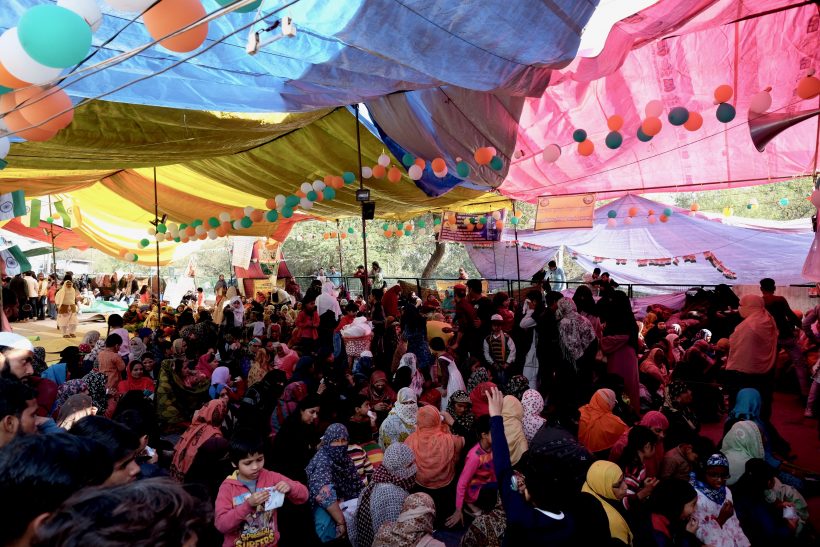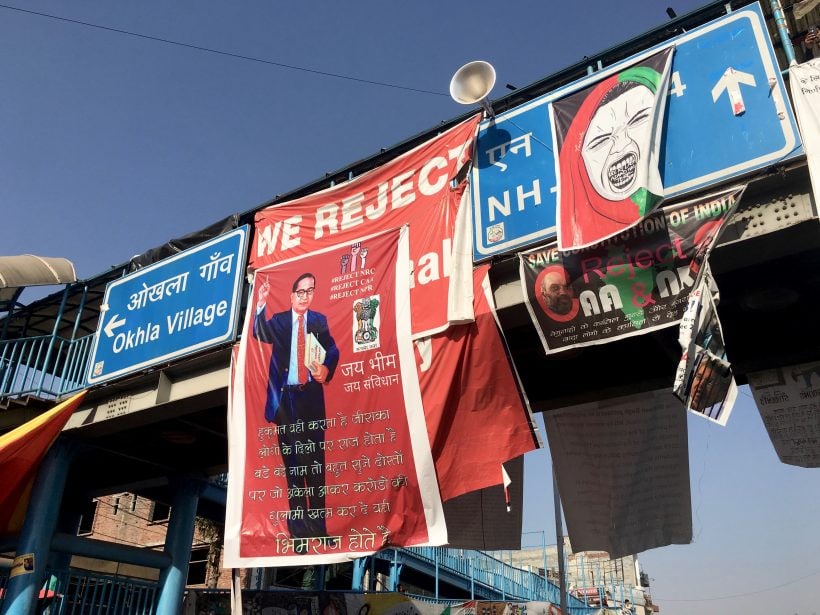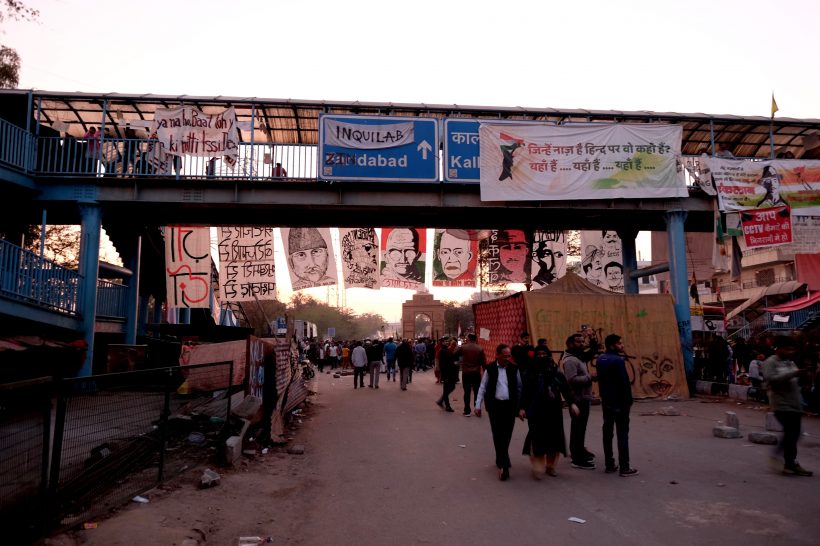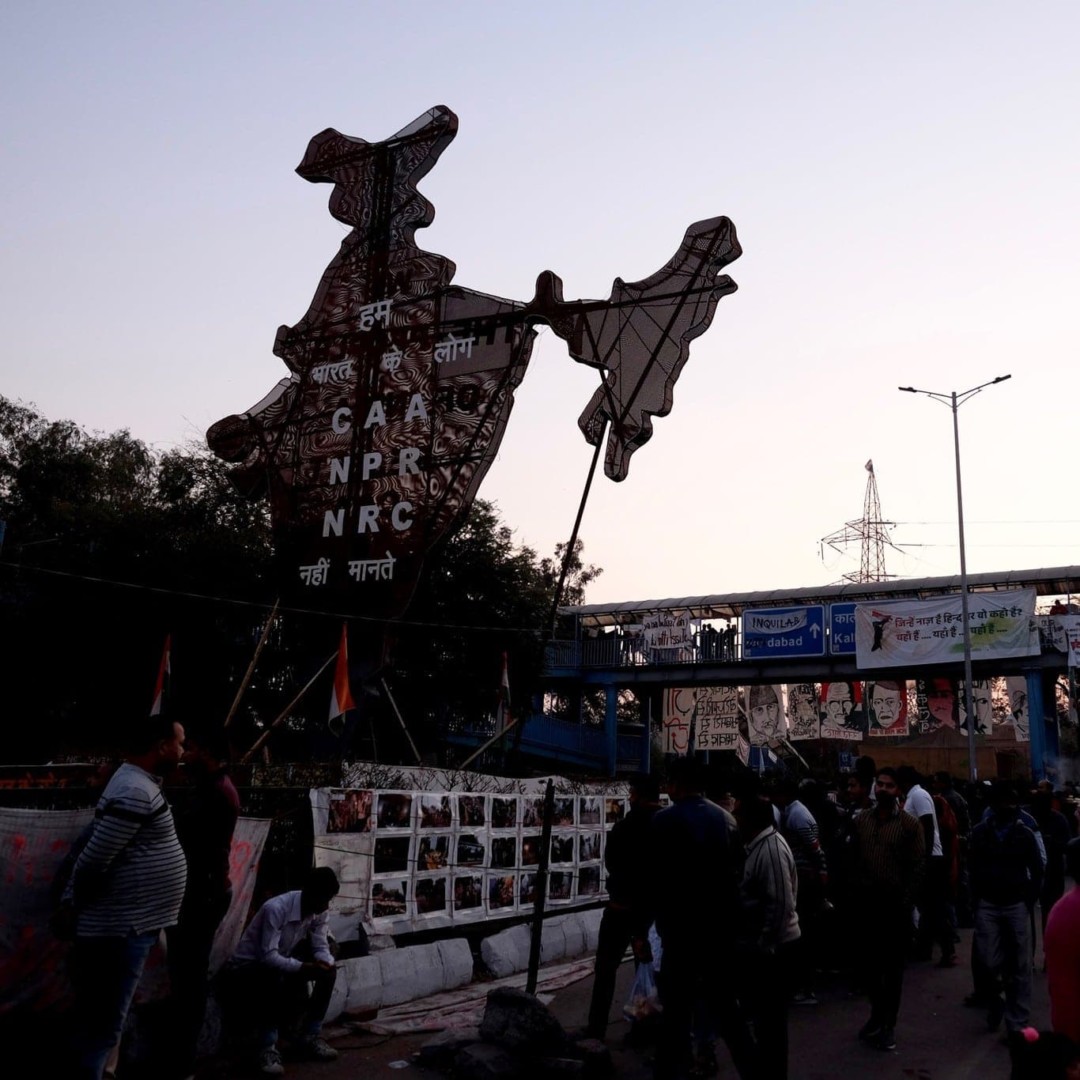February 2020. The pedestrian overpass is covered in banners. Crossing its elevated walkway, only flashes of the sky can be glimpsed through the hanging tarp, cloth and card, secured by a complicated web of string and ribbon. The banners wave in the wind, some erratically, others stubbornly, depending on their material. Even the green metal municipal road signs have been repurposed. One of them, signaling the direction to Faridabad, a major urban conglomeration south of Delhi, has been spray-painted. Its letters have been adapted to read ‘Zindabad’, and a banner fixes the word ‘Inquilab’ before it. The sign no longer registers a destination but a slogan of infinite movement: Inquilab Zindabad, ‘Long Live the Revolution’.
Below the overpass, there are no cars traversing GD Birla Marg, a typically congested arterial road. There are only crowds of people; thousands of pedestrians assembled on the pavement. The atmosphere is electric, festive. It has the feeling of a mela, replete with face painters, souvenir sellers, food stalls, and circulating drum troupes. But this is no space of mere amusement; this is Shaheen Bagh, a protest camp initiated and led by local women, which began blocking traffic in this part of India’s capital on 15 December 2019. It survived one of Delhi’s harshest winters, as well as a climate of fear and intimidation that in late February 2020 – barely two weeks after my visit – resulted in targeted pogroms led by right-wing vigilantes at similar protest sites elsewhere in the city.
The global spread of Covid-19 forced the dismantling of the physical site on 24 March 2020, but the effects of this assembly continue to cascade across the terrain of Indian politics.
The sit-in at Shaheen Bagh began after Delhi Police forcefully entered a nearby university, Jamia Millia Islamia (JMI), attacking student protestors with batons and tear gas and vandalizing their library. The students of this historic, predominantly Muslim institution had gathered to oppose the government’s recent attempts to radically redefine the terms of citizenship in India. Spearheaded by the ruling Hindu nationalist Bharatiya Janata Party (BJP), these moves threaten the republic’s secular status, underwritten in the 1950 constitution. Students at JMI, as well as at many other universities across the country, warned that a new ‘Citizenship Amendment Act’ (CAA), combined with plans for a National Register of Citizens (NRC), would work to disenfranchise Muslim citizens and accelerate the Hindu nationalist project of transforming the country along majoritarian lines. The women of Shaheen Bagh, an economically deprived and primarily Muslim community in South Delhi, joined them in this protest. The power of their action rested in part in their proud and confident assertion of a political subject often obscured in the modern republic: the Indian Muslim woman as citizen; here, made emphatically visible.

Propelling this wave of dissent – which swelled across the country and carried with it a broad spectrum of Indian citizens – was the continuing force of an act of foundation: the promulgation of the Indian constitution of 1950 and the freedoms and principles it sought to enshrine after independence from British rule in 1947. The men and women who created the conditions for this document to be written, who threw their energy and their lives into a protracted and at times violent anti-colonial struggle, were also made present in places like Shaheen Bagh. An untimely assembly of past heroes and martyrs reflected the wide range of meanings and possibilities invested in that word azaadi, ‘freedom’.
Shaheen Bagh felt so alive in part because it was crowded with the dead. Almost all of the banners covering the overpass depicted watchful ancestors. Featured prominently was the Dalit leader and architect of the constitution BR Ambedkar (1891-1956), but also the towering independence activist Maulana Abu Kalam Azad (1888-1958), the martyred revolutionary youth Bhagat Singh (1907-1931), the inevitable ‘Father of the Nation’ MK Gandhi (1869-1948), and many more. A makeshift library in a bus stand honoured the 19th century social reformers and educators Savitribai Phule (1831-1897) and Fatima Sheikh (dates unknown). These figures surveyed the action with interest and provided their tacit affirmation. This, too, is their fight.

One of the banners decorating the overpass featured painted portraits of two men hanged by colonial authorities in 1925. Both were part of a clandestine revolutionary organization, the Hindustan Republican Association, which sought to challenge British rule in India through armed confrontation. The spirit of solidarity and self-sacrifice displayed by Ramprasad Bismil and Ashfaqullah Khan, a devout Hindu and Muslim respectively, became an important symbol of unity and possibility in a 1920s India plagued with communal violence. At Shaheen Bagh, that spirit was again hailed. Ashfaq-Bismil ki yaari, virasat hai hamari, the banner read. ‘The friendship of Ashfaq and Bismil is our inheritance.’
It was not simply a friendship that was affirmed in Shaheen Bagh, but also their commitment to a shared struggle. Bismil’s fame derives from his ‘kissing of the hangman’s noose’ with Ashfaq but also his work as a poet, particularly as the author of the famous Urdu verse Sarfaroshi ki Tamanna, ‘The Desire to Sacrifice [lit. Give One’s Head]’. This patriotic poem, which calls for the joyful shedding of blood when one’s homeland is in trouble (khoon se khelenge Holi gar vatan mushkil mein hai), has been recited loudly by crowds at anti-CAA/NRC protests across the country.
The banner’s appeal to virasat, to ‘inheritance’, offers a provocative vantage for understanding the work of anti-colonial histories in contemporary India. My own research into the twenty-first century afterlives of anti-colonial violence approaches ‘inheritance’ not as a logic of linear succession but as an untimely interference – a call to responsibility from those who are no longer present, whose corporeal existence has been extinguished.
Rather than understanding ‘afterlives’ simply as the willful conjuring of the dead by the living, to serve a politics in the present, the continuing potential associated with anti-colonial histories in post-colonial India requires us to take seriously the work of the dead as entities to whom something is owed.
The dead might themselves conjure politics — calling the living to account, demanding action in a context where their struggles remain unfinished or victories once won have been sullied or reversed.

The enduring popularity of a figure like Bhagat Singh, the charismatic rebel hero hanged by colonial authorities in 1931 at the age of twenty-three, provides a rich case for thinking about how disruptive these revenants can be. Renowned as a critic of Gandhi and agitating separately from the mainstream independence movement, the young revolutionary is not easily connected to the character or compromises of the postcolonial state. Executed at such a young age, his defiant image carries a sense of potential unfulfilled, of paths not taken. Bhagat Singh is often greeted in the present not as an anachronism but as an effective and demanding interlocutor in a variety of contemporary struggles. He is effective because his challenge to power is still seen to be relevant: the social and economic inequalities he spoke against in the 1920s persist today. He is demanding in that his courage and self-sacrifice continues to set the highest standard of political commitment, an enduring model for standing up to injustice and never compromising one’s ideals, even when faced with death.
Bhagat Singh appears in twenty-first century India as a signal of unfinished business. The demand he places on the living is not an easy one to face. It throws into crisis the idea of 1947 as the end of one historical sequence (that of British rule in India) and the beginning of another (India as independent state). It suggests, as per the famous communist slogan of the late 1940s, that yih azaadi jhooti hai, ‘this freedom is a lie’.
And yet the young revolutionary’s appeal is not limited to the left: his militant opposition to established hierarchies and his capacity for self-sacrifice inspires felicitation across the political spectrum, including from the far right.
Some seek to contain his disruptive presence, portraying Bhagat Singh simply as a brave patriot who should be saluted, but who ultimately belongs in the past. But as my research has demonstrated, many individuals and groups in contemporary India accept and affirm his call to responsibility, recognizing the martyr as a ghostly comrade in a fight that continues.
Bhagat Singh was highly visible at Shaheen Bagh. His image waved from the overpass and elsewhere, transmitting a call to action, a plea to never surrender. These protests were, however, animated less by a sense of a revolution unfinished then by anger over a promise compromised or corrupted – the promise of the constitution, its grand ambitions, which have been attacked at various points throughout India’s postcolonial history but within which people continue to locate hope and imagination. The landslide re-election of Prime Minister Narendra Modi in the 2019 Indian General Election has given new energy to longer-term efforts to dismantle the constitution’s socialist and secular premises and redesign the country in a different image. But it is clear from the anti-CAA/NRC protests that that this work will be haunted by other worlds and other possibilities. Observing the spectral alliances being forged across India in recent months, seeing images of Ambedkar or Bhagat Singh raised over the barricades, it is tempting to invert Walter Benjamin’s oft-cited observation that “even the dead will not be safe from the enemy if he wins.”
Even the enemy, if he wins, will not be safe from the dead.

The revenant congregation at Shaheen Bagh was an unruly one, to be sure. This is a pantheon riven by internal disputes and rivalries – alternative visions of what the state should be, how the economy should work, who or what constitutes ‘the people’, what is meant by ‘secularism’, and so on. Santosh Sadanandan has written provocatively on the protest’s ‘contrasting intensities’. Foundational figures like Nehru or Gandhi stand in tension with martyred youth and frustrated revolutionaries like Bhagat Singh, who signal the shortcomings of that 1947-50 settlement and the need to contest enduring imperial logics. Nor is the azaadi celebrated in Delhi or Mumbai or Kolkata the azaadi demanded in Srinagar or Jammu. Indeed, another front for Modi’s offensive against the constitution was opened in August 2019 with the repeal of Kashmir’s special status. This contested territory, subject to state violence throughout its post-47 history, remains under strict curfew and communications blackout today. The people of Kashmir congregate with their own assembly of martyrs, responding to their particular demands of inheritance. But in Delhi, in this fleeting moment, the women of Shaheen Bagh conjured a precarious unity – a testament to the magnitude of the threat they face.
Their investment remains in that moment of independence – not as something ‘resolved’, a struggle ‘complete’, but as the hopeful beginnings of something better, the power of the future, the promise of a better world.
A shifting and opaque coalition running from Home Minister Amit Shah to Delhi police forces to roving squads of Hindu nationalist goondas has repeatedly attempted to crush this sense of possibility. In February, the BJP were routed in the Delhi Capital Territory elections, in spite of their attempts to whip up popular frustration around the roads and spaces blocked by anti-CAA/NRC protests. Mere weeks after this defeat, right-wing groups supporting the national government attempted to clear the roads themselves; amidst the violence, Muslim shops were burned, places of worship attacked and at least 52 people were killed. Leaders in the Aam Admi Party, who won the elections, had little to offer the victims but prayers. The protestors from Shaheen Bagh and elsewhere do not have allies in corridors of power. But they are emboldened by their alliances with the dead, who have occupied spaces with them and spurred them on in their struggle. Bilkis, an 82-years old stalwart of the sit-in, told a journalist from the Telegraph on 20 Feb, “Hamne angrezon ko bhagaya tha, tum kya cheez ho?” We chased the British away, what are you?
On 24 March, after one hundred nights and days, the Shaheen Bagh site was cleared by Delhi police – defeated, in this form at least, by the arrival of Covid-19 and the implementation of social distancing measures across India. Tributes to the possibilities – symbolic and material – opened by the protest began flooding social media under hashtags like #InquilabLivesOn. Priya Sen’s short film, Shaheen Bagh, Until Soon, demonstrates this sentiment powerfully. In India, as in countries from Brazil to Hungary to the Philippines, policing the pandemic has allowed for a neat escalation of authoritarian tendencies and partisan scapegoating. Delhi police have exploited the lockdown to arrest prominent protestors. The NRC/CAA remains in place. It was revealing that, on 24 March, it was not simply the final bastion of older protestors that were removed from Shaheen Bagh; teams were also dispersed to destroy the banners and paint over the murals, to obscure the slogans and exorcise the gaze of the watchful dead. This, apparently, could not wait.





